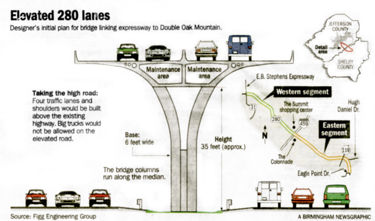U.S. Highway 280
U.S. Highway 280 (also known as U.S. Route 280, formerly the Florida Short Route) is a spur of U.S. Highway 80. It currently runs for 392 miles from Blitchton, Georgia at U.S. Highway 80 to Birmingham at I-20/I-59. For much of its route, U.S. 280 travels through rural areas and smaller cities in southern Georgia and southeastern Alabama. Once the highway approaches Birmingham, it becomes choked with commuter traffic and sprawling suburban development. Numerous shopping centers are located on U.S. 280 throughout northern Shelby County and southern Jefferson County. Throughout Alabama, U.S. 280 is paired with the unsigned Alabama State Highway 38. Previously the route had been known as Alabama State Highway 91, now reassigned to a highway in Cullman County.
Before the construction of the Red Mountain Expressway (officially the Elton B. Stephens Expressway), U.S. 280 entered Birmingham on Arlington Avenue. In the 1930s the ten-mile length of the Florida Short Route between Mountain Brook Village and the Cahaba River Bridge was lined with rose bushes as one of the city's Rose Trails, which were established by the Exchange Club with plants and funds donated by a number of garden clubs, women's clubs and individuals. With the county declining to contribute to its upkeep, the rows were maintained instead by WPA workers under the direction of landscape architect B. C. Leeming until the Alabama Highway Department began maintaining them in 1941.
Construction of the route connecting the Florida Short Route to U.S. Highway 31 (the Montgomery Highway) at a point just south of Rosedale High School began in 1953. That work proceeded in anticipation of a future route over or through Red Mountain, which many at the time assumed would take the form of a tunnel which would bypass the congested Five Points South and empty out at 6th Avenue South.
A 1960 report to the Birmingham Downtown Improvement Association recommended an open cut instead of a tunnel. Construction of the 210-foot deep, 1,640-foot long Red Mountain cut was completed in 1970, with an elevated highway crossing over Southside with exists at 8th Avenue South and between 4th and 3rd Avenues. The bridge ended abruptly at 2nd Avenue North until the connection to Carraway Boulevard and I-20/59 was completed in the mid-1980s.
In Talladega County U.S. 280 is known as the "Jim Nabors Highway", in honor of the Sylacauga, native. In Georgia, U.S. 280 from Columbus to I-16, is known as "Power Alley".
Proposals for relieving traffic congestion
As early as 1972, congestion piling up at Office Park was causing significant nuisances to rush hour commuters. A contemporary account cited confusion over whether Alabama or Mountain Brook owned the light at that intersection. Similar issues prevailed at Rocky Ridge Road and Cherokee Road at that time.
In June 2005 the University Transportation Center for Alabama at UAB completed a traffic impact study and visualization of seven alternative approaches to traffic congestion relief on Highway 280. The study was commissioned by the Regional Planning Commission of Greater Birmingham with support from Progress 280 and ALDOT. The result of the study was that significant reduction to morning travel time could be realized with construction of urban interchanges east of I-459, but that new interchanges west of I-459 would have little impact.
Upgrading Grants Mill Road as a parallel corridor would have no impact on 280's congestion. Implementation of Bus Rapid Transit service would have a significant impact at specific interchanges, but would make less of an impact on travel times for the corridor as a whole. The prospect of making at-grade improvements to intersections, as outlined in Horizon 280's improvement plan, would offer negligible benefit east of I-459, but improvement to the Rocky Ridge Road/Green Valley Road intersection would positively impact that specific bottleneck.
As a comparison, a brief evaluation of adding two lanes to the eastern part of the corridor was made, indicating the improvements were possible, but with several caveats. The study concluded that the most improvement could be realized through a combination of improvements that included adding urban interchanges and extra lanes east of I-459, reconfiguring the Rocky Ridge/Green Valley interchange either as an urban interchange or by offsetting the intersections, and considering Bus Rapid Transit as part of a regional transit plan.
During 2006, Brice Building Company constructed the $25 million Cahaba Village on the former dirt pile which included a reconfiguration of Green Valley Road's intersection, as well as moving an existing water main and burying an existing drainage ravine in a culvert. The center opened in February 2007.
In June 2006 Progress 280 hired Figg Engineering Group of Tallahassee, Florida to complete a design study for an elevated tollway along the median of Highway 280. Linda Figg presented her schematic designs to the group on August 17, 2006. The task force voted to accept the plans and begin a process of public hearings before submitting them, with any changes, to ALDOT for the funding and scheduling process.
Figg's conceptual design showed a 35-foot-tall elevated four-lane bridge handling 2-way traffic over 10 miles of Highway 280 from Elton B. Stephens Expressway to Eagle Point Drive. The bridge sections would span 150 feet or more between single piers located in existing medians. The design and locations of interchanges, including one at I-459, have not been determined.
Figg's firm was also hired to conduct the public meetings needed to secure community approval for the project. A January 22 meeting focusing on the eastern segment was attended mostly by Shelby County residents who generally support the proposal. A meeting about the western segment the next day was attended by numerous opponents carrying "No Elevated" signs. Philip Morris, an architecture and landscape historian, told the group that the structure shown in the proposal "destroys one of the most beautiful approaches to any city in the United States."
In June 2009 the Metropolitan Planning Organization approved $1 million in funding for Figg Engineering to further study the feasibility and perform preliminary design engineering for elevated lanes between I-459 and Double Oak Mountain. Governor Bob Riley publicly backed the plan and moved for the state to make it a funding priority under the newly-created Alabama Toll Road, Bridge and Tunnel Authority.
Meanwhile the Citizens to Save 280 hired a different consulting engineer, Walter Kulash of North Carolina, who recommended an alternative scheme of new side streets, allowing the elimination of traffic signals near the I-459 interchange for less than the cost of the elevated tollway. That alternative was taken up by ReThink280, a group including residents and business leaders in North Shelby County.
Kulash refined his plans and presented a more detailed proposal in June 2011. Specifics included sinking the roadway in the area of Office Park, Green Valley Road, and Cahaba Village and re-designing the Elton B. Stephens Expressway interchange at the highway's western terminus. According to his projections, the recommendation would cost $180 million to construct and not require significant acquisition of right-of-way. ALDOT disputed his projections and requested additional details for analysis.
ALDOT's selection of a project manager for the elevated toll road was delayed while officials met with local officials and residents to discuss support for the plan.
In 2012 ALDOT began accepting bids for sensor-controlled adaptive traffic signals for the stretch of US 280 between Elton B. Stephens Expressway and Doug Baker Boulevard. Those were installed in late 2012. By January 2013 some drivers were reporting minor improvements in highway driving time, though there were some complaints about short green lights for side streets.
During 2013 significant modifications were made to several interchanges near the western end of U.S. 280. The "Florida Short Route" (Pump House Road) was cut off from its intersection with Rocky Ridge Road close to the highway. An east-bound acceleration lane was added to the median at Green Valley Road. The traffic signal at Mountain Brook Plaza (Brook Manor Drive) was removed, with eastbound traffic entering from the shopping center forced to turn around at Hollywood Boulevard. Similarly, traffic which formerly crossed lanes to enter 280 from Cherokee Road and Office Park now must make U-turns. Also, eastbound through-lanes at Cherokee Road no longer face a traffic light and westbound lanes at Overton Road have a new traffic signal.
Cities along the route
From south to north:
- Vidalia, Georgia
- Cordele, Georgia
- Plains, Georgia
- Americus, Georgia
- Columbus, Georgia
- Phenix City
- Opelika
- Sylacauga
- Childersburg
- Harpersville
- Westover
- Chelsea
- Hoover
- Mountain Brook
- Homewood
- Birmingham
Major Highway Junctions
- U.S. Highway 80 and I-16 at Blichton, Georgia
- U.S. Highway 25 and U.S. Route 301 at Claxton, Georgia
- U.S. Highway 221 at Vidalia, Georgia
- U.S. Highway 23, U.S. Highway 319, and U.S. Highway 341 at McRae, Georgia
- U.S. Highway 129 at Abbeville, Georgia
- U.S. Highway 41 and I-75 at Cordele, Georgia
- U.S. Highway 19 at Americus, Georgia
- U.S. Highway 27 from Cusseta to Columbus, Georgia
- U.S. Highway 43 from Phenix City to Opelika
- I-85 and U.S. Highway 29 from Opelika to I-85, Exit 62
- U.S. Highway 231 from Sylacauga to Harpersville
- I-459 in Birmingham
- U.S. Highway 31 from Homewood to I-20/I-59 in Birmingham
- U.S. Highway 78 at Birmingham (3rd and 4th Avenue South exit). Prior to the completion of the Elton B. Stephens Expressway, U.S. 78 and U.S. 280 overlapped until they junctioned with U.S. Highway 11 at the intersection of 1st Avenue North and 24th Street.
- U.S. Highway 11 at the exit with 1st Avenue North and 26th Street in downtown Birmingham.
- I-20/I-59 in downtown Birmingham. This is the western terminus of U.S. 280.
References
- "Motorists are invited to view lovely rose trail after its 'dressing'" (February 1941), newspaper clipping in the Manual of Beautification compiled by Marion Brooks and held at the Birmingham Botanical Gardens
- "State engineer reports— Work on Highway 31 to begin within year" (June 1952) The Birmingham News - via Birmingham Rewound
- Marshall, David (January 1972) "Highway 280 traffic mess real tangle" The Birmingham News - via Birmingham Rewound
- "U.S. Route 280." Wikipedia, The Free Encyclopedia. 21 Mar 2006, 13:28 UTC. 13 Apr 2006, 18:55 [1].
- "Fun facts, historical tidbits and tips to find your way around Birmingham from traffic engineer John Garrett." (January 2, 2007) The Birmingham News
- MacDonald, Ginny (June 10, 2009) "MPO approves elevated U.S. 280 study." The Birmingham News
- Gray, Jeremy (January 20, 2010) "Crowd gathers in Homewood for alternative 280 plan." The Birmingham News
- MacDonald, Ginny (March 6, 2010) "U.S. 280 work on express lanes slows so foes can offer views." The Birmingham News
- Singleton, William C. III (June 16, 2011) "Alternative unveiled for Birmingham's US 280 traffic." The Birmingham News
- Gray, Jeremy (February 4, 2012) "U.S. 280 in Birmingham and Shelby County to get traffic signals designed to aid flow." The Birmingham News
- Smith, Mike D. (January 15, 2013) "Drivers see some changes as new U.S. 280 traffic signals 'learn' the route." The Birmingham News
- Smith, Mike D. (July 31, 2013) "First segment of U.S. 280 changes scheduled to go into effect Friday evening." The Birmingham News
- Smith, Mike D. (August 11, 2013) "U.S. 280: What's next for the corridor trapped by the growth it creates?" The Birmingham News


